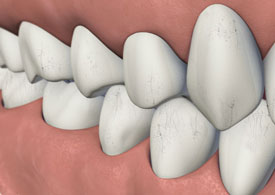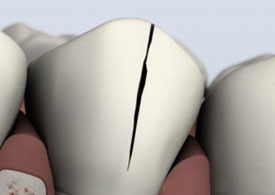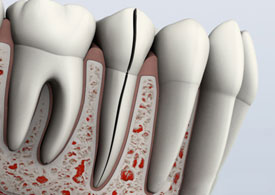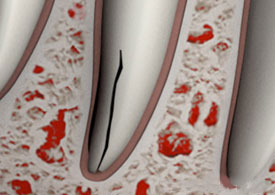Cracked Teeth
Today, people live longer and more stressful lives than in the past. They expose their teeth to many more years of damage from such behaviors as clenching their teeth, grinding them or chewing on hard objects. While these habits make our teeth more susceptible to cracks, the good news is that dentists are helping people keep their teeth longer with sophisticated dental procedures.
Symptoms of a cracked tooth include:
- Erratic pain when chewing
- Pain after releasing biting pressure
- Pain when your tooth is exposed to temperature extremes
In many cases, the pain comes and goes, making it difficult for your dentist to locate the tooth that is causing discomfort.
Inside your tooth, under the white enamel and a hard layer called the dentin, is a soft, inner tissue called the pulp, which is a connective tissue that contains cells, blood vessels and nerves.
Chewing on a cracked tooth can cause movement of the pieces of hard outer tissue, which irritates the pulp. The crack can close quickly when biting pressure is released, which causes a sharp, momentary pain. Chewing can irritate the dental pulp over and over again, resulting in so much damage to the pulp that it can no longer heal itself. The tooth may also become sensitive to temperature extremes. In time, a cracked tooth may begin to hurt without any biting or chewing pressure to trigger it. If the pulp tissue becomes infected or inflamed, this can spread to the bone and gum tissue surrounding the tooth.
Cracked teeth can be sometimes difficult to diagnose. Once diagnosed, endodontic treatment (root canal treatment) may be the solution to saving the tooth. While all dentists receive basic training in the diagnosis and treatment of cracked teeth, a dentist will sometimes refer their patients to a specialist in root canal treatment – an endodontist. After they complete their dental training, endodontists receive at least two additional years of education. That additional training includes the diagnosis and treatment of unusual dental pain, such as you may have with a cracked tooth.
Like cracks in a windshield, cracks in teeth often start small and progress slowly to a larger problem. That’s why early diagnosis is important. The sooner a crack is detected and treated, the better the chance of saving your tooth. The endodontist’s special training and experience is invaluable in the case of damage from a cracked tooth.
This is FAQ answer. Click to edit this text. Lorem ipsum dolor sit amet, consectetur adipiscing elit. Ut elit tellus, luctus nec ullamcorper mattis, pulvinar dapibus leo.
This is FAQ answer. Click to edit this text. Lorem ipsum dolor sit amet, consectetur adipiscing elit. Ut elit tellus, luctus nec ullamcorper mattis, pulvinar dapibus leo.
How Will My Cracked Tooth Be Treated?
The type of cracked tooth and the damage sustained from it varies from patient to patient. The type, location and extent of the crack will determine the treatment and outcome for your tooth. Some categories of cracked teeth are:

Craze Lines
Craze lines are extremely common in adult teeth. They are very shallow, tiny cracks that affect only the outer enamel. They cause no pain and are of concern only because of appearance.

Fractured Cusp
The cusp of your tooth is the pointed part of the chewing surface. With a Fractured Cusp, the cusp is weak, resulting in a fracture and causing pain. Your dentist may have to remove the weakened cusp or it may break off by itself. Either way, the pain will usually be relieved. Root canal treatment is usually not needed since a fractured cusp rarely damages the pulp. Your dentist will restore your tooth with the appliance of a full crown.

Cracked Tooth
With a cracked tooth, the crack extends vertically from the chewing surface of the tooth down towards the root. Early diagnosis of this condition is important, because an untreated crack in a tooth will become worse over time, eventually resulting in the loss of the tooth. It is sometimes difficult to determine the extent of a crack, even with high magnification and special lighting, but early diagnosis and treatment are essential in saving these teeth. Because of the position of the crack, damage to the pulp is common even though a cracked tooth is not completely separated into two distinct segments. The crack may extend below the gingival tissue line, making extraction of the damaged tooth necessary, but more frequently, root canal treatment is used to treat the injured pulp. Your dentist can restore your tooth with
a crown that holds the pieces together and protects the cracked tooth.

Split Tooth
A split tooth is often the result of a cracked tooth that is not diagnosed early. The crack in the tooth worsens until the tooth splits into distinct segments that can be separated. A split tooth cannot be saved intact. Some portion of the tooth may be saved, depending on the position and extent of the crack. Endodontic treatment and a crown or other restoration by your dentist may be used to save a portion of the tooth, but this is rare.

Vertical Root Fracture
A vertical root fracture is formed by cracks that move from the inside out. These cracks begin in the root of the tooth and extend upward toward the chewing surface. They frequently go unnoticed because they show minimal signs and symptoms. The surrounding bone and gum may become infected before vertical root fractures are discovered. Removal of part of the fractured root with endodontic surgery may save a portion of the tooth, but frequently, treatment involves extraction of the tooth.
The fracture in a broken bone will heal, but the fracture in a cracked tooth will not. Some cracks will continue to progress and separate despite treatment, and the tooth will be lost. While it is no guarantee of success, placing a crown on a cracked tooth provides the maximum protection.
Whether it saves the tooth in the long run, treatment for a cracked tooth is important. It relieves the pain and reduces the likelihood that the crack will worsen. Most cracked teeth provide years of comfortable chewing once treated. Your endodontist will talk to you about your treatment recommendations and prognosis. He/she will advise you on how to keep your natural teeth and achieve optimum dental health.
Cracked teeth are not completely preventable, but you can make your teeth less susceptible to cracks by following these suggestions:
- Don’t chew hard objects such as ice, unpopped popcorn kernels or pens.
- Don’t clench or grind your teeth (Talk to your dentist about getting a retainer or mouth guard if you clench or grind your teeth while you sleep).
- A mouth guard or protective mask is a necessity when playing contact sports.
See your dentist immediately if you experience symptoms of a cracked tooth (pain when chewing or after releasing biting pressure or temperature sensitivity). A cracked tooth can often be saved if detected early enough.
